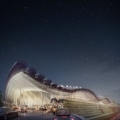Airport News

UK-based architecture firm Rogers Stirk Harbour + Partners (RSHP) has won a competition to design the new Terminal 3 (T3) building at Taiwan Taoyuan International Airport in Taipei, Taiwan.
RSHP will work alongside Taiwanese engineers CECI on the project, which will deliver a new terminal, boarding gates, concourses and a multi function building (MFB). The infrastructure works will also include a network of service roads, aprons, taxiways and an automatic people mover (APM). Construction is scheduled for completion in 2020.
A model of the proposed new terminal was unveiled to the public following the competition win, which was decided by a panel of 11 jurors from four continents including Europe, Asia, America and Africa. The panel included experts in IT, culture, green energy and airport operations. RSHP saw off competition from Foster + Partners and UN Studio to win the project.
RSHP’s design for T3 has been inspired by Taiwan’s landscapes and oceans and features a fluid architectural concept protected by an elegantly shaped hard-shell roof. The interior of the terminal will contain large open spaces to improve wayfinding and deliver transit times of approximately 40 minutes, making it one of the most efficient in the region.
Ivan Harbour, partner, Rogers Stirk Harbour + Partners, said, “We are delighted to have won the competition for the third terminal at Taiwan Taoyuan International Airport. We have worked in Taiwan for 15 years and have made many friends during that time. This competition is the product of a successful international joint venture with those colleagues. Our proposal is focused on a passenger’s experience with a deliberate strategy to absorb constant future change, whilst always retaining the integrity of its unique design. The terminal will be designed to meet the highest sustainability criteria; holistic engineering and architecture.
“We have created a rationally planned and easy to use airport that will be characterized by a flowing sequence of beautifully lit, acoustically comfortable and well-proportioned spaces. It will be an airport where the drama of the spatial experience is shared by all, at all times. The approach to the airport and the open spaces within it will have an urban quality akin to a city center. There will be a variety of buildings that, together with the new and existing terminals, will form the heart of a new compact, vibrant ‘aero’ city.”
